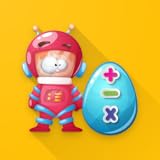Multisensory Math Instruction for Better and Faster Learning
Multisensory Math Instruction for kids with learning disabilities can make learning math easier.
Have you thought about multisensory math instruction for your child?
Using multisensory instruction to teach your child Math concepts can speed up learning. Teaching math through auditory, visual, and hands-on learning is proven by research to improve learning. It really helps children with math-based learning disabilities like dyscalculia.
Almost all math programs for kids are text-based, auditory style programs. Reading is an auditory activity, not a visual activity. That’s because reading involves words processed as language. Therefore, reading is not visual image processing.
Hands-On Math!: Ready-To-Use Games and Activities For Grades 4-8
47% OffThere are some math programs for kids that appeal to visual learners. They include many drawings, graphs, pie charts, and other visual images.
Many computer-based math programs for kids are simply text-on-screen applications. Those kinds of programs are just like textbooks. Like books, some computer programs also may include graphics and / or audio.
For true multisensory math instruction, you need to use visual, auditory, kinesthetic AND tactile learning activities. Using all of them at the same time is what makes for multisensory math instruction.
Options for Multisensory Math Instruction:
Math-U-See (MUS) is a great multisensory, hands on math program. MUS teaches through demonstration videos or DVDs, manipulatives, and workbooks. MUS provides auditory, visual, and kinesthetic learning components. It is one of the few comprehensive math curricula that is fully multisensory.
TouchMath is another great option for multisensory math instruction. The program has been developed over several years and is proven to be effective through research. The program says it is for K-3rd. However, if your child is older and still needs to work on basic math concepts, I would highly recommend using this program for mastery of the basic math concepts.
Multisensory math instruction programs that use manipulatives (Base 10, ETA Hand2mind (Formerly Cuisenaire), etc.) have workbooks and manipulatives too. However programs sometimes lack auditory/visual demonstrations, and they don’t cover all mathematic concepts from basic number skills up through complex math reasoning. The programs have books on various math concepts, but not all topics are available.
Multisensory Math Instruction through Any Curriculum
Help Your Kids with Math: A Unique Step-by-Step Visual Guide (DK Help Your Kids)
$8.99 (as of 17 December 2025 20:30 GMT -05:00 - More infoProduct prices and availability are accurate as of the date/time indicated and are subject to change. Any price and availability information displayed on [relevant Amazon Site(s), as applicable] at the time of purchase will apply to the purchase of this product.)Like multisensory reading curricula, almost any math curriculum can be adapted to use multisensory methods. Adaptation will be a lot easier if you look for a visually rich curriculum with a lot of images and graphics. If you have the text and images, you can read aloud, and use math manipulatives to demonstrate concepts.
For kinesthetic activities, you can use rhythmic dance, clapping chants, gathering sticks or stones, or other objects for manipulatives, etc.
Certain math concepts, such as measurements or money, are easy to make into multisensory math instruction activities. You can teach measuring skills by using recipes and baking with your child. You can play “store” with paper money to learn money skills.
If your child is a kinesthetic or visual learner, you’ll want to introduce concepts with hands-on, visual activities, then hit the books.
If your child is an auditory learner, you can read the books, then explore concepts with manipulatives. Either way, it is always most effective to teach through multiple channels to aid understanding and retention.
Check out our additional information about multisensory math curricula for homeschooling your learning abled kid. You may want to pay particular attention to our information about homeschooling children with dycalculia or “math dyslexia”.
Math-U-See
Math-U-See Accelerated Individualized Mastery (AIM) for Multiplication with a Bridge to Division: A Fun Math Intervention Program for Achieving Fast Math Fact Fluency
$50.00 (as of 18 December 2025 13:32 GMT -05:00 - More infoProduct prices and availability are accurate as of the date/time indicated and are subject to change. Any price and availability information displayed on [relevant Amazon Site(s), as applicable] at the time of purchase will apply to the purchase of this product.)Math-U-See Gamma Student Pack
52% OffHands-On Math












